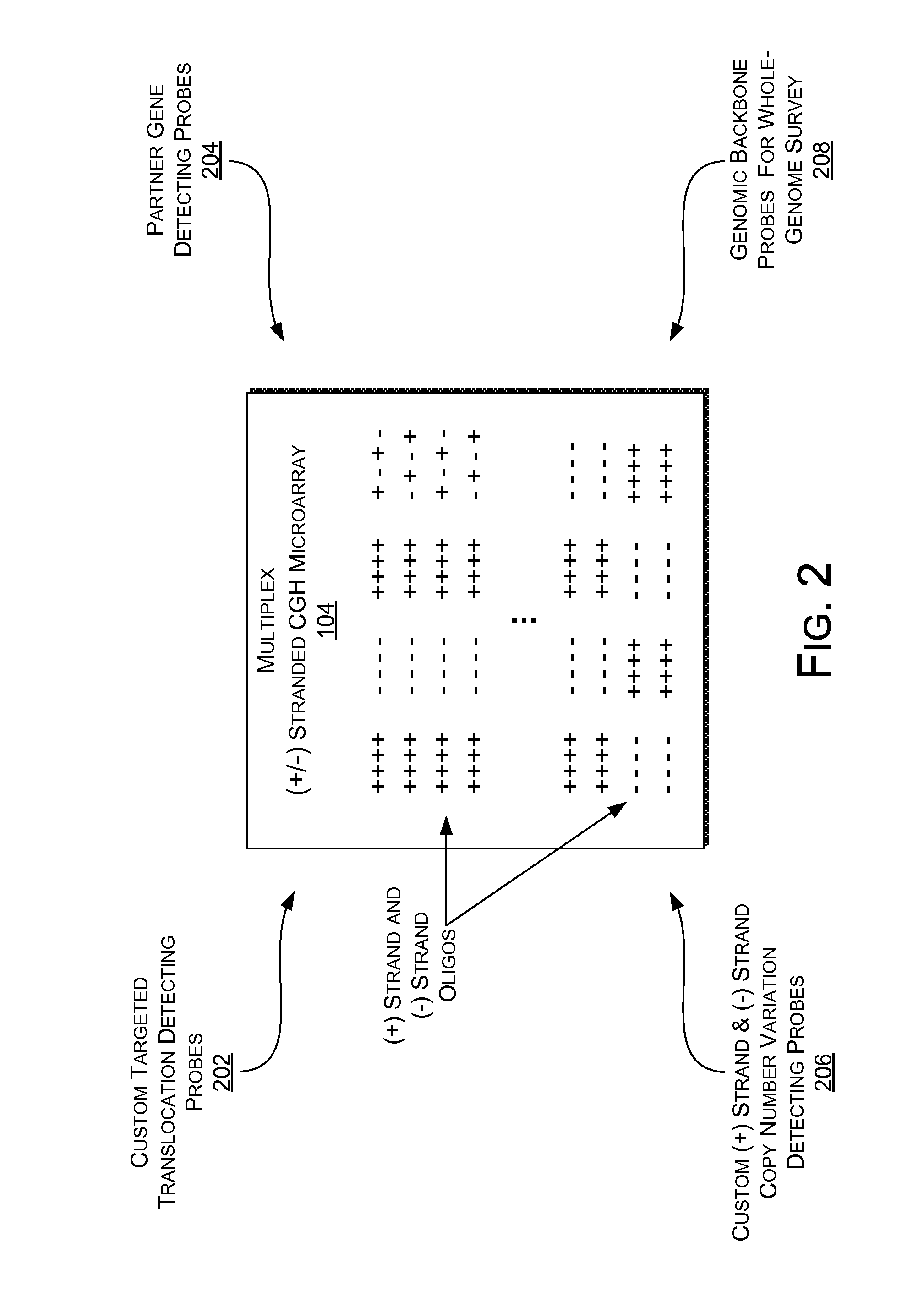Multiplex (+/-) stranded arrays and assays for detecting chromosomal abnormalities associated with cancer and other diseases
a chromosomal abnormality and array technology, applied in the field of multiplex (+/-) stranded arrays, can solve the problems of inability to comprehensively detect balanced chromosomal translocation events, minor or unnoticeable phenotypic effects of certain translocations, and more severe phenotypic consequences of certain translocations, so as to achieve comprehensive and accurate profile signatures
- Summary
- Abstract
- Description
- Claims
- Application Information
AI Technical Summary
Benefits of technology
Problems solved by technology
Method used
Image
Examples
example 1
Exemplary (+ / −) CGH Method
[0254]FIG. 1 shows an overview of a (+ / −) stranded array CGH procedure. CGH procedures compare a patient genomic DNA sample 100 with a control genomic DNA sample 102. The samples compete for hybridization targets (oligos) arrayed, in this case, on a (+ / −) stranded CGH microarray 104. The (+ / −) stranded CGH microarray 104 includes plus (+) strand oligo probes 106 and minus (−) strand oligo probes 108. Amplification primers 110 and 110′ (e.g., the same primers) are added to the patient genomic DNA sample 100 and the control genomic DNA sample 102 for carefully moderated amplification 112, for example, a linear amplification, to create probes that span regions of interest, that is, regions in which a balanced translocation may occur. The primers extend selected chromosomal regions approximately 10,000 to 20,000 bases each, providing a rich mixture of plus (+) strand and minus (−) strand DNA hybridization probes representing these regions selected because of re...
example 2
Exemplary (+ / −) CHG Microarray
[0272]FIG. 2 shows schematically the multiplex (+ / −) stranded CGH microarray 104 of FIG. 1, in greater detail. The plus (+) strand and minus (−) strand oligos constituting the hybridization targets on the array can be arranged in any suitable order or pattern. See for example, U.S. patent application Ser. No. 11 / 057,088 to Shaffer at al., entitled, “Methods and Apparatuses For Achieving Precision Diagnoses,” incorporated herein by reference. The (+ / −) stranded CGH microarray 104 may be a tiling density DNA microarray. Each (+ / −) stranded CGH microarray 104 is typically both a whole-genome array and a custom targeted array. As a whole-genome array, the (+ / −) stranded CGH microarray 104 can detect DNA copy number variations that may occur across the complete genome. As a custom targeted array, the (+ / −) stranded CGH microarray 104 specifically targets loci in numerous regions of diagnostic interest. The (+ / −) stranded CGH microarray 104 can be designed wi...
example 3
Exemplary Hardware Environment for Implementing (+ / −) CGH
[0277]Most of the steps in the example procedure shown in FIG. 1 are performed either directly or indirectly in a computing environment. That is, amplification 112, labeling 122, and quality control 132 are generally computer-controlled, computer-assisted, or computer-monitored. Scanning, analysis, display, and reporting of results in array CGH are also mediated by a computing device.
[0278]FIG. 3 shows an example computing environment and components of a (+ / −) stranded array CGH system. An example hardware component, a microarray scanner 300, is representative as a placeholder in FIG. 3 of molecular diagnostics equipment in general. The microarray scanner 300 may contain a computing device and / or may be communicatively coupled with a computing device 302. The illustrated layout is relatively elementary compared to the layout of equipment in an actual clinical diagnostics laboratory, but shows some example relationships between...
PUM
| Property | Measurement | Unit |
|---|---|---|
| Tm | aaaaa | aaaaa |
| temperature | aaaaa | aaaaa |
| temperature | aaaaa | aaaaa |
Abstract
Description
Claims
Application Information
 Login to View More
Login to View More - R&D
- Intellectual Property
- Life Sciences
- Materials
- Tech Scout
- Unparalleled Data Quality
- Higher Quality Content
- 60% Fewer Hallucinations
Browse by: Latest US Patents, China's latest patents, Technical Efficacy Thesaurus, Application Domain, Technology Topic, Popular Technical Reports.
© 2025 PatSnap. All rights reserved.Legal|Privacy policy|Modern Slavery Act Transparency Statement|Sitemap|About US| Contact US: help@patsnap.com



